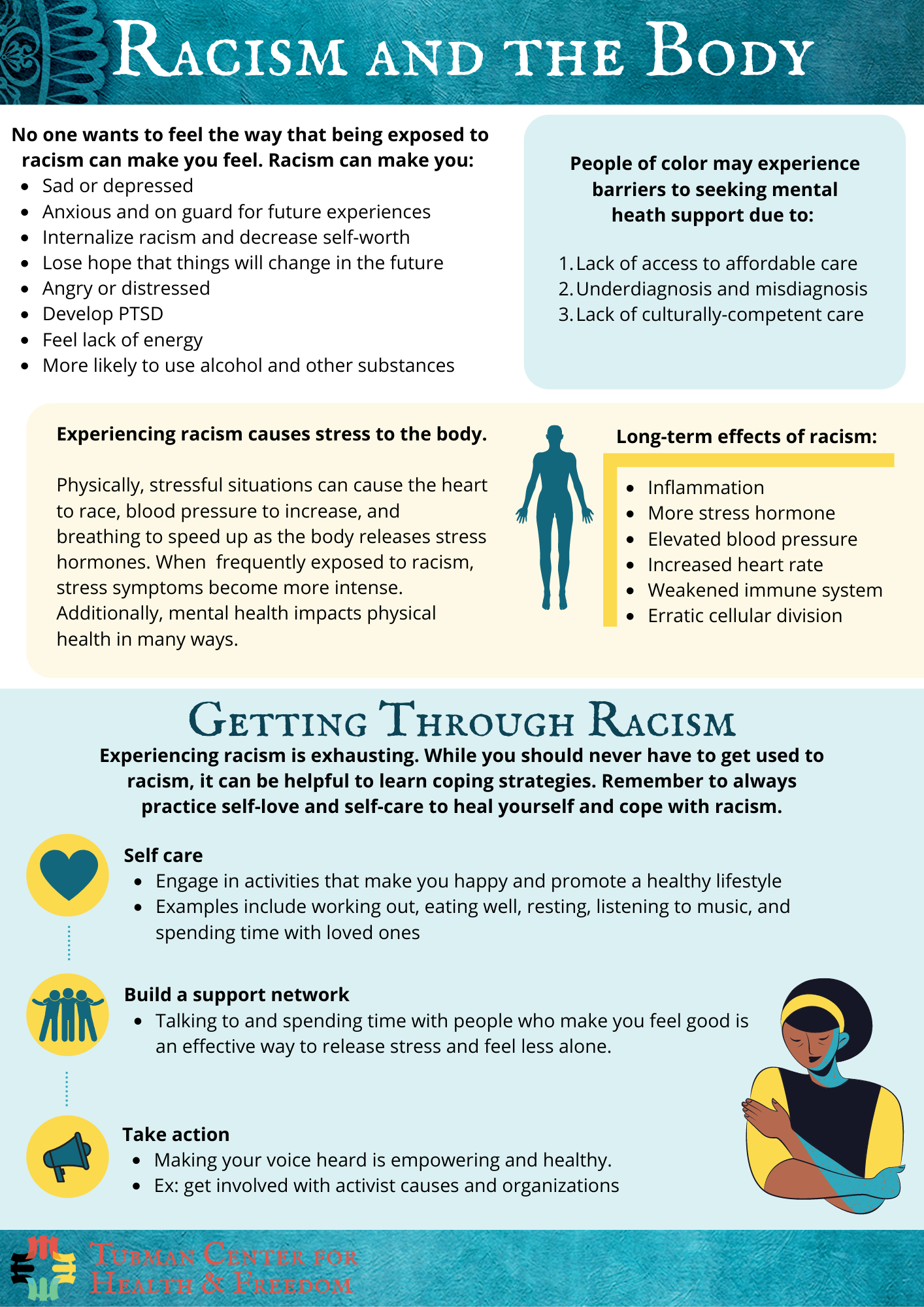Racism and the body
By Karina Patel, Policy and Communications Specialist at the Tubman Center for Health & Freedom
The lump in your throat. The pit in your stomach. The exasperated exhale that sneaks past your lips. The feeling of holding your tears back. The rush of fear, anxiety, hurt, anger, and disappointment.
Far too many of us have become familiar with the rush of emotions that follows exposure to racism. Whether it be at the micro-level—racism targeted at yourself or watching others experience it—or at the macrolevel—through the effects of policies, media portrayal, or institutions—racism operates at multiple levels.
Racism is reducing our life expectancies and impacting our overall health and wellbeing. The more racism and discrimination one is exposed to, the sicker they are. The effects we feel in our bodies are telling us the truth: this is not good for us. We now have the science to prove what we have known. Racialized weathering is a scientific term found in literature.
Racialized weathering explains how the stresses of systemic racism are closely related to the early health deterioration and negative health outcomes impacting Black and other communities of color. A growing body of research is finding that racism has a lot to do with health disparities, reminding us that disrupting health inequities will require us to think beyond the traditional domains of health policy.
For example, one study found that exposure to discrimination and segregation during juvenile years predicted adult inflammation.
Racism has become so ingrained in the way we experience the world that it begins to feel almost expected and normal. When we frequently experience racism, our bodies begin to have more severe stress symptoms.
While work can already be stressful, members of our community have to worry about the added layer of racism. In fact, a 2020 survey by the Society for Human Resource Management found that more than a third of Black workers reported being treated unfairly in the workplace in the past year because of their race.
Simply going to work every day exposes members of our communities to racism that impacts our health. Socio-economics aside, racialized weathering has been found among low-income workers, high earners and all those in between. Here are a few examples of exposure to racism within the workplace:
- During the 2021 election season, King County Councilmember Kathy Lambert’s campaign sent out a fear-mongering flyer. The flyer depicts her opponent, Perry, as a “socialist puppet” controlled by Democrats of color including King County Councilmember Girmay Zahilay (who was not even a candidate up for re-election). In an October 6 tweet, Councilmember Zahilay questioned “why [Lambert] singled out and used her only Black colleague’s face for fear mongering on the East side.” While she initially defended her actions, after losing multiple endorsements, Lambert issued a formal apology. This experience is nothing new for political figures of color. In May, New York City mayoral candidate Andrew Yang was the subject of a political cartoon perpetuating the idea that Asian Americans are permanent tourists and outsiders. And throughout his presidency, President Barack Obama was the subject of multiple political cartoons with racist undertones. There’s no doubt that this offenses compound and impact the health of those targeted.
- During the January 6 Capitol riots, Black Capitol police officers say they were targets of racial slurs. In an interview with CNN, Officer Harry Dunn said that the “Black officer struggle was different” because rioters “showed that they hated us and they hated our skin color.” By downplaying the seriousness of the threats before January 6, upper management’s inaction meant that Black police officers were left especially vulnerable during the riots. One particularly striking video captured during the riots is the one of a lone Black police officer being chased up Capitol stairs by a mob of Trump supporters. One can imagine the trauma experienced by the Black Capitol Police Officers on the Hill that day and how that incident may compound with other exposures to racism to take not only a mental, but physical toll on one’s body.
- Life changed for Muslim and Sikh Americans on September 11, 2001. In the aftermath of 9/11, Arabs, Muslims, Hindus, Sikhs, North Africans, South Asians, West Asians, and those so perceived as responsible for the terrorist act have faced hate crimes, workplace discrimination, bullying, and racial and religious profiling. From being denied jobs for wearing hijabs and turbans to being called “Bin Laden” by co-workers, the examples of discrimination are endless. The stresses of everyday life for those impacted by the events of 9/11 have real health impacts. For instance, one study found that Sikh and Arabic-named mothers were at higher risk for giving birth to babies with low birth weight after September 11, 2001, compared to the year before.
At Tubman Health, we believe that we must have healthcare that addresses racialized weathering. Anything less does not meet the needs of racially marginalized communities and only further perpetuates health inequities.
We are all just trying to live our lives and provide for our families, but when racism is mixed in with work, things get a lot more complicated. Racism is far more detrimental than some fleeting hurt feelings; it truly interferes with our ability to live a healthy life and impacts us on the cellular level.



